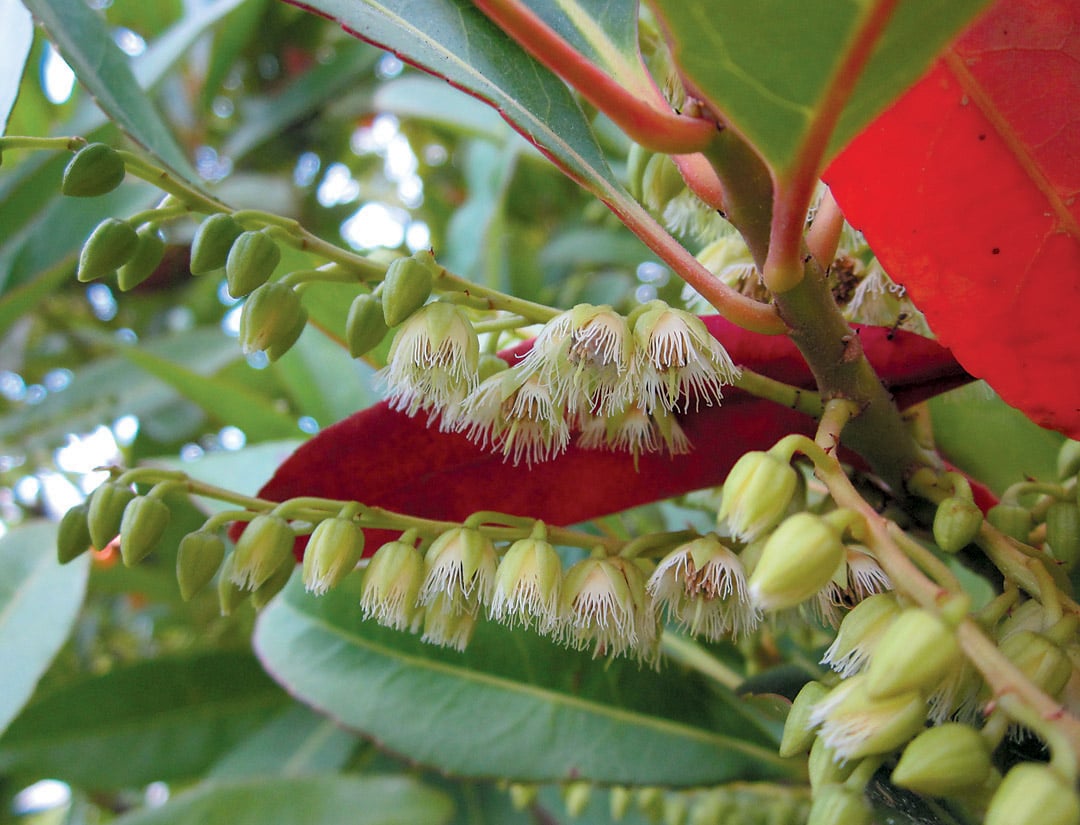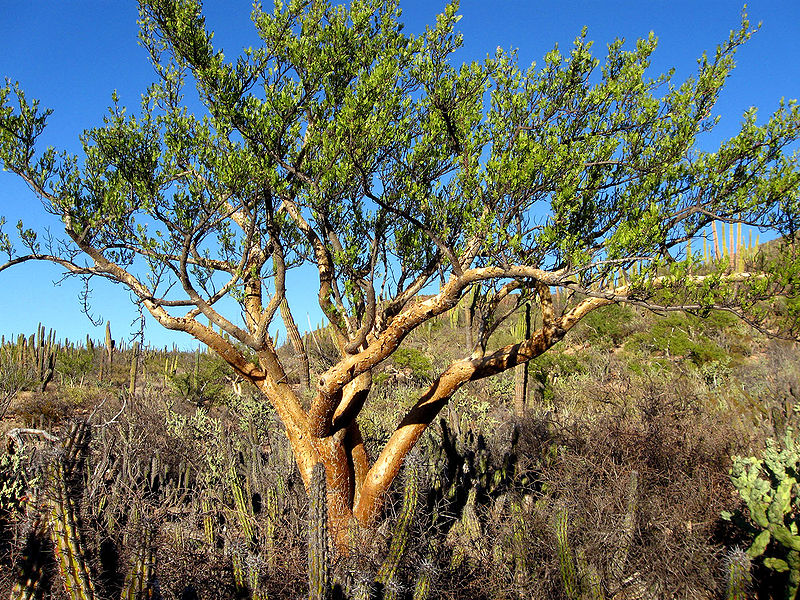

Contributor
- Topics: Archive, Growing for Biodiversity

Japanese blueberry tree (Elaeocarpus decipiens) is a beautiful, broad-leaved evergreen from East Asia. Its compact form, lush growth, and elegant branching pattern make this tree a great lawn, garden, or street tree with almost year-round appeal. In spring, bronze-colored leaves emerge and soon mature to a luxuriant, shiny dark green. Before the previous season’s leaves fall, their chlorophyll degrades, revealing a brilliant reddish orange color in the dying leaves. This colorful ornamental effect lasts for several months; the leaves shed slowly, leaving the canopy and ground below dotted with the vibrantly colored older leaves. In summer, lantern-shaped, fragrant, cream-colored flowers with delicately fringed petals, appear inconspicuously witihin the canopy and under the foliage. These small flowers are harbingers of the interesting fruits that follow.

The common name for this species is derived from the olive-shaped fruits that range in color from dark blue to bruise purple to nearly black. Other species of Elaeocarpus make brilliant, cobalt blue fruit, shaped like large marbles. The hard, highly figured internal part of the fruit of several species, but especially the Rudraksha tree (E. ganitrus), is famous for its use as Hindu prayer beads. Rudraksha, meaning tears of Shiva, comes from the myth of the Hindu god drinking the deadly Halahala poison churned up from the world ocean. As his throat burned and turned blue, Shiva cried tears of compassion that rolled from his cheeks to the earth as blue Elaeocarpus fruits.

An Avian Connection
The bluish purple fruit and bright red older leaves on Japanese blueberry tree provide a remarkable color contrast. These colors may have evolved in the more ancestral tropical members of the genus—and not by accident. The greatest diversity in the genus Elaeocarpus is in New Guinea, where one of its most important seed dispersers is the cassowary—a large flightless bird with a vividly colored blue, orange, and red wattle. The similarities between the colors of Elaeocarpus fruits and leaves and a cassowary’s wattle may not be a coincidence. The wattles are used as social signals between the birds to attract mates, and Elaeocarpus may have evolved colors that cassowaries naturally respond to. Or perhaps the blue and reddish orange Elaeocarpus colors evolved in the cassowary, making the birds more attractive to potential mates by reminding them of a tasty meal. No one can say for sure. What is for certain is that cassowaries have little difficulty finding fallen blue fruit among the colorful fallen leaves under an Elaeocarpus tree.

A Large Genus
Elaeocarpus (pronounced ee-lay-oh-KAR-puss), which means oily fruit, is a large genus with about 350 species. Other members of the genus, mostly from the Old World tropics, are important for timber, medicine, food, and as sources of dyes. Chilean lily of the valley tree (Crinodendron patagua), which is occasionally grown in the western United States, is a member of the same plant family, the Elaeocarpaceae. The famous plantsman Morgan “Bill” Evans (see Pacific Horticulture, Fall 1996, page 8) was instrumental in introducing Japanese blueberry tree to West Coast horticulture. It was initially introduced as E. decipiens, but that name is sometimes treated as a synonym of E. sylvestris; the nomenclature remains somewhat muddled.
Japanese blueberry tree is a low maintenance, small to medium sized tree that typically matures at between twenty and thirty-five feet in height with a similar canopy width, but it may become taller with age. It appears to be relatively pest free, grows well in full sun or partial shade, and prefers well-drained soil and regular water until established. Records indicate that this species has been grown in Seattle, Vancouver, and Portland for over fifteen years with little or no noticeable frost damage. It also apparently thrives in Southern California, where it has been planted in Santa Monica and San Luis Obispo.
Japanese blueberry trees are still uncommon in the western US, but as more and more gardeners discover their many virtues, they are becoming more widely grown. If you decide to plant one of these exotic trees, hold a recently fallen leaf next to the fruit and think of Shiva, New Guinea, and cassowaries.
Share:
Social Media
Garden Futurist Podcast
Most Popular
Videos
Topics
Related Posts

Ground Up Science for Greener Cities with Garden Futurist Dr. Alessandro Ossola
Spring 2023 Listen to the Podcast here. Alessandro Ossola is a scientist who gets very excited about the challenge of climate change allowing for an

Readying Urban Forests for Climate Realities with Garden Futurist Dr. Greg McPherson
Winter 2023 Listen to the Podcast here. “Going from the mow and blow to a more horticulturally knowledgeable approach to maintaining the landscape. And that

Welcome, Greywater, to the Garden
Summer 2022 Oh, summer: delightful warm air, tomatoes swelling on the vine, fragrant blooms on an evening stroll. When it’s warm and rainless, how is

Big Tree-Data and Big-Tree Data with Garden Futurist Matt Ritter
Summer 2022 Listen to the full Garden Futurist: Episode XV podcast here. We are in an environmental crisis right now in many parts of California










Responses